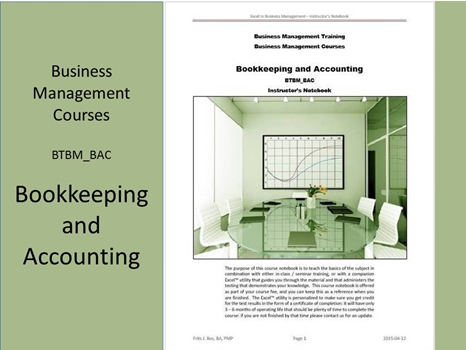
Bookkeeping & Accounting BTBM_BAC
Many people are intimidated by accounting, or they try to avoid spending any more time than necessary in the company of financial statements. Reality is that success in business is dependent on your ability to comfortably relate to financial information that reflects the lifeblood of a company. If you run your own business you must know exactly what the status is of your financial health in order for the business to survive and flourish. If you set your sights on a corporate career, then with additional responsibilities most promotions will make it increasingly important that you are well versed in accounting and finance.
You need a solid foundation in financial accounting to understand how, what, and where business transactions are recorded in an accounting system. The context for this course is of a small- to medium-business both to illustrate the concepts and to provide examples that are more comprehensive for an understanding of what is involved in managing financial information.
This course delivers 3 parts dealing with:
- Introduction to Accounting Principles provides the understanding of what accounting is and why we go through the effort of keeping meticulous records of business activity.
- Bookkeeping Principles explains the mechanics of record keeping so you will be familiar with all the steps involved in analyzing and recording business activity.
- Financial Accounting goes into more detail in terms of both theory and application, and in explaining how financial results are reported. We also explore how to establish your own computer-based accounting system.
Our basic Payroll Accounting component provides a solid understanding of what payroll tasks must be performed, and how this fits in with the other accounting tasks. Usually companies outsource payroll to a specialized service provider – what we focus on is your ability to review those services, and in the course of business planning to make sure you get the correct results by computing the payroll costs using the CRA website payroll calculator. A good understanding of payroll is useful to setup accounting systems (especially automated systems) to make sure all required processes are initialized. Most accounting software provides a mechanism to update relevant tax and remittance tables so that you can simply automate much of the process (and use the CRA website as part of your QA verification that your automation results are correct).
Introduction to Accounting Principles
- Define accounting, and describe the users of accounting information
- Explain why ethics and rules of conduct are crucial in accounting and business
- Describe and discuss the forms of business organizations
- Explain accounting standards, and describe the concepts and principles
- Describe and use the accounting equation to analyze business transactions
- Set up a chart of accounts for a business and prepare and evaluate financial statements
Bookkeeping Principles
- Define key accounting terms and their use, emphasizing the rules of debit and credit
- Analyzing and recording journal transactions and posting from the journal to the ledger
- Excel™ model – Bookkeeping: Journalizing Transactions
- Explore the Trial Balance to close the accounting period.
- Bank reconciliation, cheques, debit cards, and credit cards
- Excel™ model – Bank Reconciliation: automating the reconciliation
Financial Accounting
- Prepare journal entries for the five types of adjustments
- Understand and apply revenue recognition and matching expenses
- Prepare an adjusted trial balance sheet for a service business
- Prepare financial statements from the adjusted trial balance.
- Explore “automated accounting” using Excel™ workbooks (learn to use Excel™ formulas)
- Excel™ model – Financial Reporting: an Accounting Worksheet to complete the Accounting Cycle using Excel™
- Close the revenue, expense, and withdrawal accounts
- Classify assets and liabilities and prepare a Classified Balance Sheet
- Calculate current ratio and debt ratio
- Understand the difference between the perpetual and periodic inventory system
- Account for the purchase and sale of inventory under the perpetual inventory system
- Prepare a cash flow statement
- Perform the adjustments and closing transactions for a merchandising business.
- Principles of payroll accounting in accordance with CRA.
Learning Formats BTBM_BAC
This course is currently available in a classroom setting (public or company private) with approximately 60 contact hours.
PDF – Certificate Of Completion
This course offers a certificate of completion that identifies the course, the student, and a brief description of the course. To receive a certificate the student must have attended at least 80% of the course sessions. This personalized certificate is forwarded to the student by Email.
PDF – Course Notebook
This course includes a notebook in PDF format that provides the minimum knowledge the student must master in order to obtain the certificate. In the notebook you will find references to other study materials. Students receive the notebook by Email when their registration is confirmed.
PDF – Program Overview
An overview of this study program can be downloaded from the website by right-clicking on the program link on the enquiry page.
PDF – Current Training Schedule
A list of upcoming training sessions can be downloaded from the website by right-clicking on the schedule link on the enquiry page.
Registration – Service Providers
To register for any training course please look on the enquiry link page of your service provider (from where you accessed this website). On the page you will find a registration request form where you can order the course that you are interested in. The availability dates will be provided to you, along with payment instructions if you decide to go ahead.

 |
|